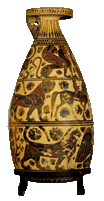Early Archaic Period
Circa 700 - 600 B.C.

Click image for interactive viewing
During this period, the concept of the polis, the Greek city-state, became
well developed. Tyrannical political figures seized control of many of these
city-states in the 7th and 6th centuries.
Greek colonies abroad continued to flourish and new settlements were established,
particularly in the region of the Black Sea. Colonies were founded at Mediterranean
sites such as Cyrene on the North African coast and Massilia (Marseilles)
in southern France. Highly developed commercial contacts continued in Egypt,
Anatolia and the Levant. These contacts stimulated an influx of eastern imports
and the manufacture of Greek objects with an "oriental" appearance
or featuring "oriental" motifs.
Coinage was invented by the East Greeks or by the Lydians, the neighbors of
the Greeks on the coast of Asia Minor, and was systematically adopted by the
Greek city-states. The first Greek monumental stone sculpture appeared. The
Doric and Ionic architectural orders were born and the Greek temple reached
its developed form.
 |
Early Corinthian Alabastron
Click image for interactive viewing.
ca. 620-590 BC
By the Scale Painter
Vulci, Chamber Tomb 5
MS 553
The powerful city of Corinth was the innovator in pottery decoration
and dominated pottery exportation in the 7th and early 6th centuries
BC. This vessel comes from an Etruscan site in central Italy, a region
where Greek commercial contacts and influence were strong.
The decorative motifs include exotic animals, "oriental" creatures
such as the sphinx, and filler ornaments such as rosettes.
H. 35.0; Dia. 17.0 cm. Photo by Maria Daniels for the Perseus Project
(182k)
|
© Copyright 2002




